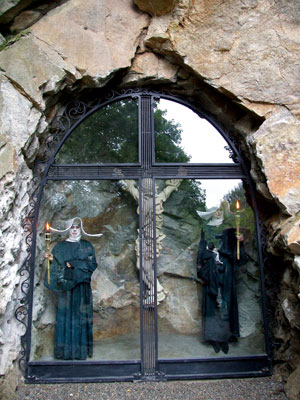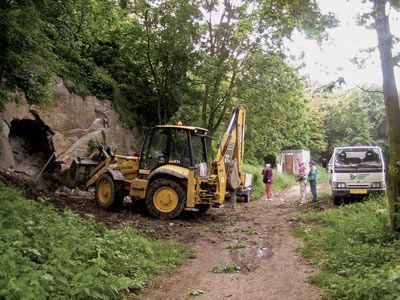In 1984, the ceramic work Deliverance from Suffering (1978), in which the artist combined references to all the artistic directions that have so far existed into a harmonic whole, became the emblem of the jubilee exhibition in Landsberg.
After a lifetime of travel, the stulpture has now found its complete fulfilment at the seventh station in Znojmo.
 Kristek created the ceramic sculpture Deliverance from Suffering, which shows the theme of Christ, for the rock chapel. Although Christ may be seen as crucified, his arms are merely spread. Kristek established a new typology of the Crucifixion and attempted to capture relativity in the perception of the cross. Through his work he points to the liberation, unchaining and uplifting which the path of art offers. Christ is not hung on the cross, but the cross is present in the form of an iron gate. And so the pilgrim is the victim of an illusion - a spatial trompe l’oeil. If he stands at one angle, he sees Christ on the cross, but if he takes a step to the side, Christ is taken down from the cross. And in the same way, Christ in the rock chapel is exposed to an illusion. From the aspect of the ceramic sculpture, the arriving pilgrim and the entire world surrounding him hang on the cross. And so the sculpture Deliverance from Suffering begs the question – how valid and objective are our statements? For the path of art is unpredictable, and the individual artefacts cannot be interpreted in an unambiguous and objective way. The artist should never offer an interpretation of his own work. Each work is open and offers an infinite number of interpretations depending on each viewer.
Kristek created the ceramic sculpture Deliverance from Suffering, which shows the theme of Christ, for the rock chapel. Although Christ may be seen as crucified, his arms are merely spread. Kristek established a new typology of the Crucifixion and attempted to capture relativity in the perception of the cross. Through his work he points to the liberation, unchaining and uplifting which the path of art offers. Christ is not hung on the cross, but the cross is present in the form of an iron gate. And so the pilgrim is the victim of an illusion - a spatial trompe l’oeil. If he stands at one angle, he sees Christ on the cross, but if he takes a step to the side, Christ is taken down from the cross. And in the same way, Christ in the rock chapel is exposed to an illusion. From the aspect of the ceramic sculpture, the arriving pilgrim and the entire world surrounding him hang on the cross. And so the sculpture Deliverance from Suffering begs the question – how valid and objective are our statements? For the path of art is unpredictable, and the individual artefacts cannot be interpreted in an unambiguous and objective way. The artist should never offer an interpretation of his own work. Each work is open and offers an infinite number of interpretations depending on each viewer.
Text: Barbora Půtová




